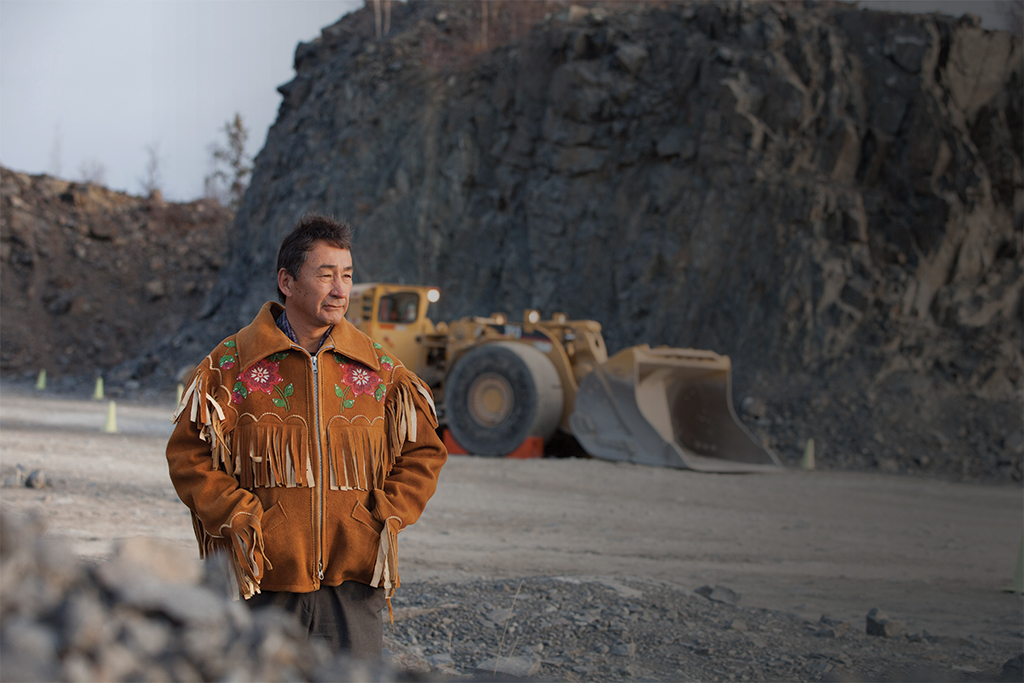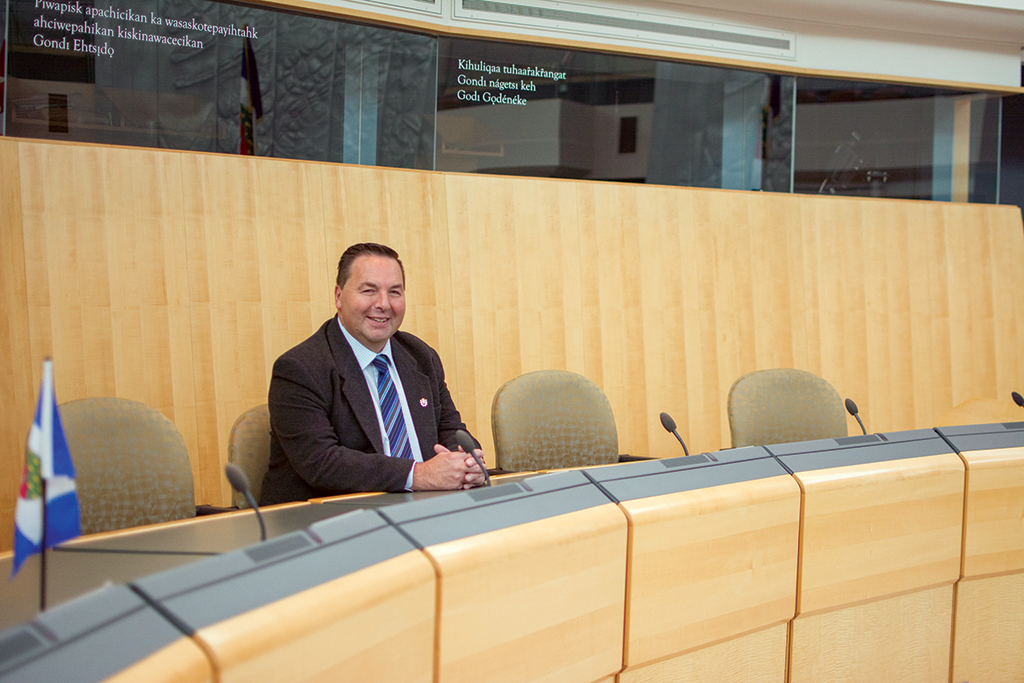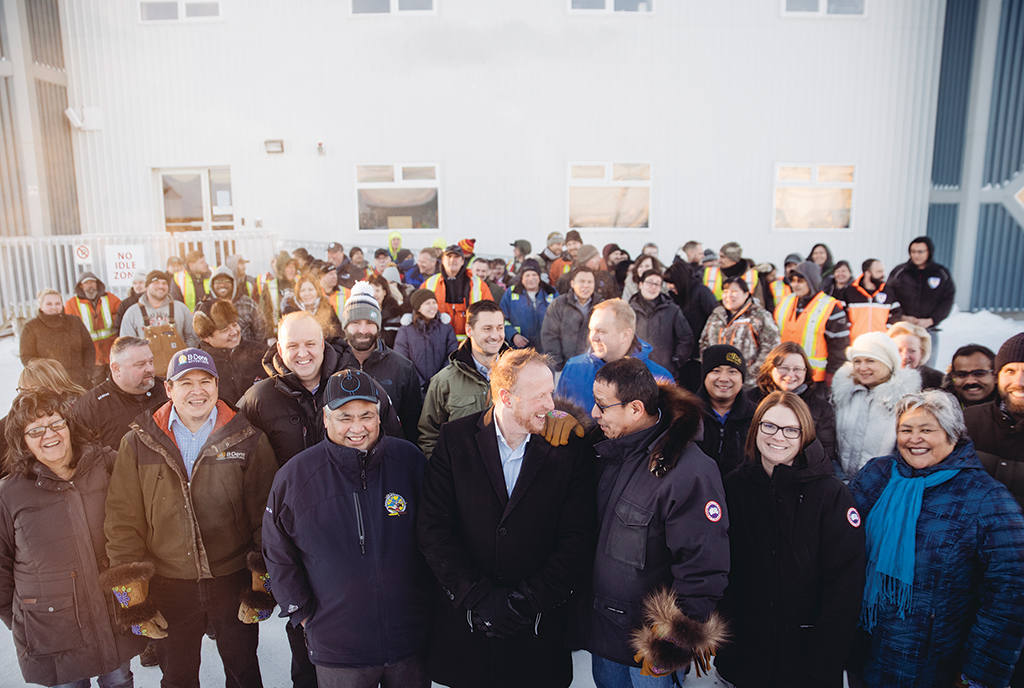THE MACRO VIEW

The NWT’s diamond mines have driven the regional economy for years and supported many businesses and Indigenous-owned development corporations. With the mines winding down, what comes next?
By Michael Ganley
The first diamond mine in the NWT, Ekati, began production 21 years ago. Since then, the diamond industry has contributed $19.3 billion to the NWT’s gross domestic product, or an average of almost $1 billion per year. The diamond mines – Ekati, along with Diavik, Gahcho Kué and Snap Lake – have spent $14.6 billion with Northern businesses and $6.5 billion with Indigenous-owned businesses since 1996. Over that time, the industry has been the largest single driver of the territory’s economy and has affected everything from where roads get built to job opportunities to the nature of Northern business itself.
But those figures only begin to tell the story of the influence the diamond mines have on the social and economic well-being of the NWT. The wealth generated by those tiny stones dug up around Lac de Gras has spurred the growth of all kinds of private enterprises and of Indigenous-owned development corporations. The development corporations, in particular, have grown from small, local operations to large, sophisticated businesses and have stretched their wings beyond mining and the territory’s borders.
But concern hangs in the air. As diamond production declines over the coming decade, the question of what will replace them is being asked by business people, politicians and regular citizens alike. While nothing is certain, the very businesses that have grown and been nourished by the resource sector will be an important part of the answer.
Plenty of Upside
Every year, the Government of the Northwest Territories produces a report on the Socio-Economic Agreements that govern the relationship between the government and the diamond mines. In addition to the figures quoted above, the 2018 report says that, over the past 10 years, the territorial government has collected almost $100 million in revenue from the diamond mines each year. This revenue has come from corporate, property, fuel and payroll taxes – accounting for 44 per cent of the GNWT’s total tax revenue in recent years – and from resource royalties. The government has collected an average of $71 million in royalties since 2009.
The report also says that 70 per cent of the mines’ total procurement has been spent with Northern businesses and 31 per cent with Northern Indigenous-owned businesses. In 2017 alone, the diamond mines spent $324 million with Northern Indigenous businesses.
By any standard, those numbers are impressive, but what do they mean on the ground, to the people of the NWT? The Tlicho Investment Corporation (TIC) is one of the development corporations that has taken advantage of the wealth generated by the diamond mines to build its businesses. TIC is owned by the Tlicho government for the benefit of band members from the communities of Behchokò˛ Gamètì, Wekweetì and Whatì. Today, depending on the time of year, TIC employs between 250 and 300 people who work at the diamond mines. Contracts to build and maintain winter roads add another 100 people. “That’s the norm,” says TIC’s CEO, Mark Brajer. “We’re making a little bit on that, but it’s hiring the Tlicho people that is the big benefit. And we don’t get every position filled by Tlicho, so the benefits flow elsewhere, too.”

TIC, like most development corporations in the territory, has Impact and Benefit Agreements (IBAs) with the diamond mines, which set out rights and responsibilities on both sides. The company has taken a further step in its own development recently by buying an equity stake in the 97-kilometre all-season road that is expected to be built to Whatì by 2022. That means that not only will TIC’s companies be involved in building and maintaining the road, but the development corporation will also have an asset in their investment portfolio and a source of ongoing revenue. The road will help make Fortune Minerals’ NICO deposit, which is expected to operate for two decades, economical. Mining the deposit of cobalt, gold, bismuth and copper will require heavy use of the road, meaning money in the pockets of TIC – and other – businesses.
Jobs, Jobs, Jobs
On account of their sheer size, the larger development corporations like TIC and Det’on Cho Corporation (DCC) get the bulk of the direct contracts with the mines. But, says Paul Gruner, the CEO of DCC, that only means that the company creates employment for people well beyond its home base of Yellowknife. He gives the example of DCC’s wholly owned catering company, Bouwa Whee. It employs about 180 people, 90 per cent of whom are local and 65 per cent Indigenous, and they come from right across the territory. “The plane from Hay River is full of folks going to Bouwa Whee or the mines,” Gruner says. “There are opportunities even if they’re not in your backyard.”
In total, through wholly owned companies and joint ventures, DCC employs 800 people. “Extrapolate that through Tlicho, Denesoline, Métis etc., you will very quickly get up above 2,000 people,” Gruner says. “At an average wage of 100,000 per year with wages spent locally, taxes etc., you’re talking about several hundred of millions of dollars.” The town of Hay River is a perfect example of the diamond mines’ extended reach. It is not a partner to any IBAs, but got heavily involved in diamond mining from the start and has never looked back. Much of the credit goes to Russell and Mary King, the former owners of Kingland Ford, King Manufacturing and many other businesses in and around Hay River. They started a mining division when BHP Billiton opened Ekati and got their foot in the door from Day 1. They supplied vehicles and industrial equipment and quickly established that they could build chutes for the processing plant. They grew their involvement over the years and, in 2015, sold most of their businesses to Edmonton-based Go Auto. At the time, the businesses had around 100 people working at the mines.

“The plane from Hay River is full of folks going to Bouwawhee or the mines.”
And the repercussions don’t stop there. The King’s business savvy rubbed off on some of their employees, who over the years launched and grew their own businesses. The NWT’s Minister of Industry, Tourism and Investment, Wally Schumann, is a case in point. He worked for Kingland Ford for years and was a partner with the Kings in their body shop. He went on to found the NWT’s largest sign manufacturer, Poison Graphics, which has done signage for every mine in the territory and wins business in Nunavut. “I started my own outfit and thanks to the Kings knew what I had to do,” Schumann says. “You have to be aggressive and approach the mines but you have to be competitive at the same time.” The business has been in a blind trust since Schumann became a minister, but is now in the process of being sold to one of the employees, with the hope that he will be able to build on its past success.
Three-hundred-and-twenty kilometres northeast of Hay River, the tiny, isolated community of Lutselk’e has been forging its own economic activity from nearby mining. It is the closest community to Gahcho Kué and has IBAs with each of the diamond mines. The community’s development corporation, Denesoline Corp., operates as a not-for-profit society the beneficiaries of which are the members of the community. Denesoline has won the Governor General’s award for business excellence the last two years. “We have about 10 lines of business ranging from explosives at the diamond mines to building the ice road to owning bulk freight companies,” says CEO Ron Barlas.

“With these mines going past maturity things are tightening up and there’s a lot of pressure on everybody to start exploring different ways to address the challenges.”
“Collectively, those companies employ many hundreds of people.” Denesoline doesn’t get involved in the day-to-day operations of the businesses, preferring to take an investment position and receive income. That income can either be reinvested in the businesses or used to improve the quality of life for the residents of Lutselk’e. “People leave these communities because there is nothing to do there is no quality of life,” Barlas says. “For the first time, they now have a food truck and a cafe and a youth centre. These things enhance the quality of life for people in Lutselk’e.”
Denesoline and the other development corporations will have important roles to play as the diamond mines wind down. They are already discussing the ramifications and working to determine how best they can come together to maintain a healthy economy. Diversification will be part of the answer, with tourism being one frequently cited option. Brajer, the CEO of TIC, expects the new all-season road to Whatì will bring opportunities to his region for tourism-related businesses. “When the all-season road is done, it’s going to be an area where, not unlike Tuktoyaktuk, there will be tourists and people flowing up who will want to stay and eat and all that stuff,” he says. The key is to build sustainable businesses in the smaller communities that can cater to the travellers and keep jobs – and money – in the local economy. TIC has a number of businesses in the communities, including hotels and retail locations, but Brajer says there are lots of other opportunities. “There will be a need for bakeries and campsites and all kinds of services.”

Sustainable Through Diversification
TIC has also diversified its business geographically, with two trucking businesses that serve Alberta. “We’ve been trying to build those businesses up,” Brajer says. “We took those businesses over right before the downturn of the economy in Alberta, so that’s been a bit of a challenge, but we’re hopeful they’ll develop into solid businesses that provide a return for the communities.”
Finding ways to keep the existing diamond mines chugging along for a little longer will also help bridge any gap. That means lowering costs to keep them profitable. “With high operating costs, we’re all going to have to work together to get as much life out of these mines as we can,” Schumann says.
But there’s no question that supporting and enabling new exploration and development of the mining sector in the NWT will be a crucial part of the equation, and that work in that direction needs to be done now.
Darrell Beaulieu is the CEO of Denendeh Investments Inc., which holds a variety of for-profit investments for the benefit of all the NWT’s Dene First Nations. “With the sun setting on the diamond mines, there’s a lot of work to be done,” he says. “It takes almost a decade or more to get a major project permitted, financed and developed. With the diamond mines shutting down within the next 10 years, we’re on the verge of having not too much to look forward to.”
He would like to see steps taken to stimulate investment in exploration for both minerals and oil and gas. Both need basic infrastructure like roads and power, but he also cites the need for social infrastructure like schools, hospitals and water systems.
Near-term opportunities include investments in the Taltson hydroelectric expansion, which would triple the existing power plant’s generation capacity and link the electrical grids north and south of Great Slave Lake, a road through the Slave Geological Province, and the Mackenzie Valley Highway. These would not only provide work in the short and medium turn, but would open up mineral deposits for the mining sector and oil and gas fields along the Mackenzie River and up to the Delta.
Schumann says he and NWT Premier Bob McLeod have been hosting economic summits with all interested parties, including the development corporations, to discuss ways to seed the NWT economy. “With these mines going past maturity things are tightening up and there’s a lot of pressure on everybody to start exploring different ways to address the challenges,” he says. ABQ

